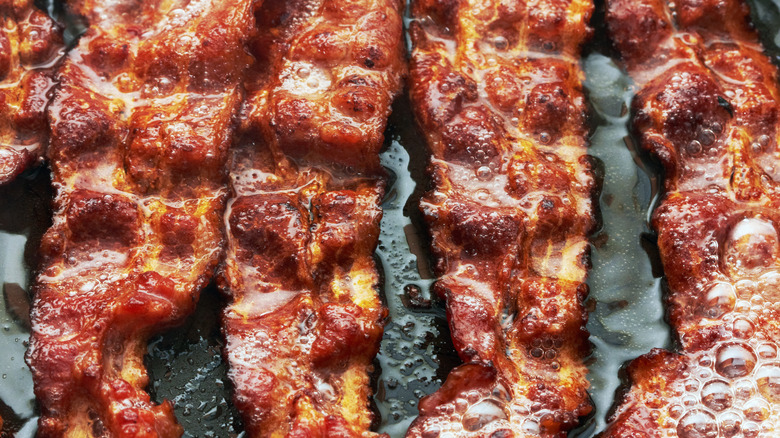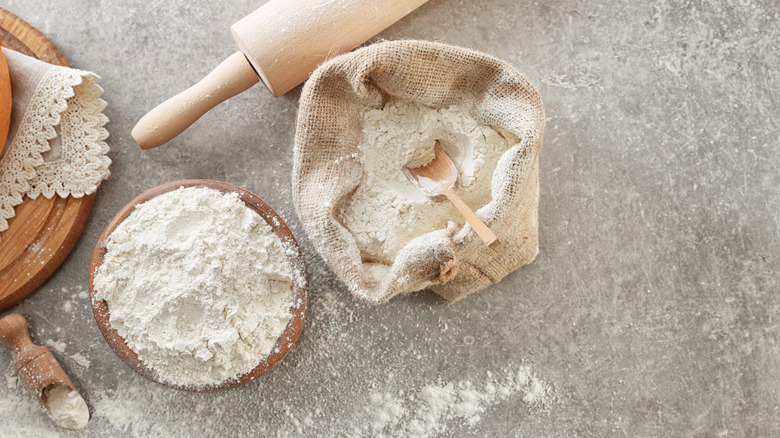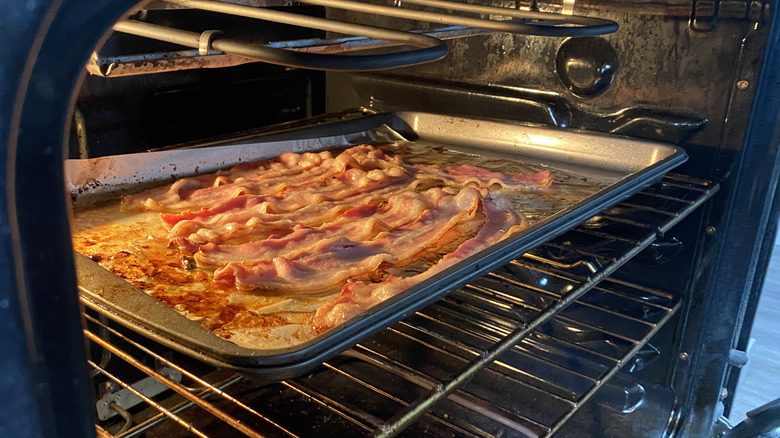One Unexpected Ingredient Will Always Give You Crispy Bacon
Everything is better with bacon. From Cobb salads, to bacon-wrapped dates, to Bloody Mary garnish, bacon adds a touch of rich umami flavor and a tantalizing crisp to anything it's paired with. So we're all on the same page, we're referring to American bacon, contrary to Canadian bacon (ham), British back bacon, or Italian pancetta, baring the distinct fat-marbling along each strip. Bacon's humble beginnings start with a cut of fatty pork belly, which undergoes a multistep smoke-curing process before it is eventually sliced, packaged, and incorporated into nearly any genre of food imaginable including ice cream and even whiskey.
Though some may prefer their bacon soft and chewy, the decadence of a melt-in-your-mouth, perfectly crisped bacon strip is unparalleled. There are a handful of tricks that claim to produce the crispiest, premium bacon, like shingling the strips so each slice is fried in the fat of its neighbor. Another common tip to make bacon crispier is to bake it in the oven on a sheet pan, avoiding the mess of stove-top frying and providing consistent heat for uniform crispiness. America's Test Kitchen even recommends cooking bacon in water to reduce grease splatter, help the meat retain moisture and tenderness, and render the fat more effectively. But adding one simple ingredient to your bacon-making process can yield the crispiest, most delicious bacon you've ever had.
Flour power
The biggest obstacle to frying bacon is the relationship between heat and fat. If you cook it low and slow for too long, too much fat may render off, resulting in tough, jerky-like strips. If you fry too fast, the fat may seize up and get gristly, or worse, the strips could burn. These aforementioned cooking tips may help avoid some of these bacon blunders, but just a touch of all-purpose flour can ensure your bacon comes out remarkably crispy, without losing its tender and flavorful fat. Lindsay Champion at Pure Wow suggests next time you cook bacon, try lightly coating your strips in flour before cooking to get perfectly crisp, succulent bacon strips (while also reducing grease splatter too).
Dredging your bacon in flour works to elevate it in a couple of different ways. First, the flour absorbs excess grease and moisture so the bacon begins browning quicker and doesn't splatter as much in the pan. But more importantly, as the grease-flour coating cooks, it forms an outer crust, contributing to the overall taste and crispiness, encasing each strip to retain internal moisture, and keeping the bacon from curling onto itself while preserving its flavor and tenderness. Bon Appétit says that for even more exceptional results, try refrigerating your bacon for a few hours between dredging and cooking to allow the flour ample time to absorb and stiffen with the bacon grease.
Bakin' bacon
When it comes time to actually cooking your flour-coated bacon, there are a couple of different options as well. The tried-and-true option would be a shallow fry in a cast iron pan, but there's more room for error and inconsistency with this method given the limited temperature control and gradual buildup of rendered fat in the pan. Air fryers are a viable option as well, though they may not have the space available to cook full batches without crowding. For convenience and ease, folks at New York Times: Cooking recommends baking your strips in the oven on a sheet tray for 10 to 20 minutes at 450 degrees Fahrenheit. Not only is it fast, but it produces uniformly cooked strips, and the ambient oven heat allows the Maillard reaction (browning and crisp-ifying) to occur all over the strip, rather than just the pan side (via Tasting Table).
Though bacon usually just plays a supporting role in a dish, it's a vital role and should be allowed the opportunity to be its most perfect, crispy self. A light flour coating followed by a short bake in the oven will help bring the best out of your bacon's flavor and texture. As bacon lovers around the world clamor to find the next best tip for elevating the bacon game, the notion of dredging bacon has opened the door to a world of possibilities for bacon experimentation.


